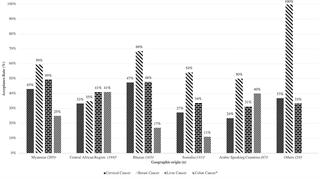PLOS ONE ( IF 3.7 ) Pub Date : 2020-03-30 , DOI: 10.1371/journal.pone.0230675 Amy Raines Milenkov 1 , Martha Felini 1 , Eva Baker 1 , Rushil Acharya 1 , Elvis Longanga Diese 1 , Sara Onsa 1 , Shane Fernando 1 , Holy Chor 2

|
Background
Refugees are less likely than US born populations to receive cancer screenings. Building Bridges is a community health worker prevention program designed to increase refugee’s cancer screening uptake. The purpose of this cross sectional analysis was to assess differences in uptake of cervical, breast, liver, and colorectal screens across six cultural groups.
Methods
Data was abstracted in 2018 for this analysis. Participants were categorized into six cultural groups (Myanmar, Central Africa, Bhutan, Somalia, Arabic Speaking Countries, and Other) to assess differences in sociodemographic measures and screening uptake. Uptake proportions were calculated for each cancer type (cervical, breast, liver, and colon) among eligible participants, by gender and cultural group. Differences in uptake across groups were assessed using stratified analysis and logistic regression. Prevalence odds ratios (POR) and 95% confidence intervals (CIs) were calculated for each group to assess the association between screening completion and cultural group.
Findings
874 refugees were asked about cancer screening history. The majority of participants were either ‘never had been screened’ or ‘not up-to-date’ for every cancer screening. Among age eligible, 82% had no prior pap exam within the past 3 years, 81% had no prior mammogram within the past year, 69% didn’t know their Hepatitis B status and 87% never had a colon cancer screening. Overall, higher uptake of all types of cancer screenings was observed in Myanmar and Bhutanese groups, except colon cancer screening which was higher among Central African Region and Arabic Speaking participants.
Conclusion
Screening uptake varied by ethnic group and screening type. The program reached an under and never screened population, however, the proportion of refugees who received a cancer screening remained low compared to the US population. Diversity within refugee communities requires adaptation to specific cultural and linguistic needs to include new Americans in cancer elimination efforts.
中文翻译:

2014-2018年,北德克萨斯多种族难民人口中接受癌症检查的人数。
背景
与美国出生的人口相比,难民接受癌症筛查的可能性较小。Building Bridges是一项社区卫生工作者预防计划,旨在增加难民对癌症筛查的吸收。这项横断面分析的目的是评估六个文化群体在子宫颈,乳腺,肝脏和结肠直肠筛检中的摄取差异。
方法
数据在2018年进行了抽象分析。参加者分为六个文化类别(缅甸,中非,不丹,索马里,阿拉伯语国家和其他),以评估社会人口统计学措施和筛查摄取的差异。根据性别和文化组别,计算了合格参与者中每种癌症类型(宫颈癌,乳腺癌,肝癌和结肠癌)的摄取比例。使用分层分析和逻辑回归评估各组的摄取差异。为每组计算患病率比(POR)和95%置信区间(CI),以评估筛选完成与文化组之间的关联。
发现
向874名难民询问了癌症筛查的历史。每次癌症筛查的大多数参与者都是“从未接受过筛查”或“不是最新的”。在符合条件的年龄组中,有82%的人在过去3年内没有做过子宫颈抹片检查,有81%的人在过去一年中没有进行过乳房X线检查,有69%的人不知道自己的乙型肝炎状态,有87%的人从未进行过结肠癌筛查。总体而言,在缅甸和不丹人群中观察到所有类型的癌症筛查的摄取都较高,除了结肠癌筛查在中非地区和讲阿拉伯语的参与者中较高。
结论
筛查摄入量因种族和筛查类型而异。该计划的对象是未接受筛查的人口,但从未接受筛查,但是与美国人口相比,接受癌症筛查的难民比例仍然较低。难民社区内的多样性要求适应特定的文化和语言需求,以使新的美国人参与消除癌症的工作。



























 京公网安备 11010802027423号
京公网安备 11010802027423号